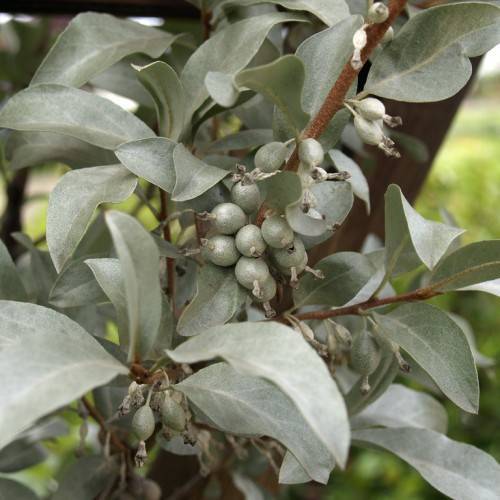
Silverberry (Wolf Willow)
Elaeagnus commutata
Also Known As - wolf willowCycle:
Perennial
Watering:
Minimum
Hardiness Zone:
2
Flowers:
Flowers In Summer
Sun:
Full sun Partial sun
Soil:
Sandy,Loamy,Clay,Rocky
Fruits:
Fruits In Autumn Ready In Fall
Leaf:
Yes
Growth Rate:
Moderate
Drought Tolerant:
Yes
Salt Tolerant:
Yes
Thorny:
Yes
Invasive:
Yes
Care Level:
Medium
watering
Silverberry (Wolf Willow) (Elaeagnus commutata) should be watered weekly during the growing season (spring to late-summer). Water deeply until the soil is saturated. During the winter months, water when the top inch of the soil feels dry to the touch. Make sure to water early in the day, so that the foliage of the plant has time to dry off throughout the day.
sunlight
Silverberry (Elaeagnus commutata), also known as wolf willow, is an easy-to-care-for plant species that thrives in full sun and well-draining soils. It prefers a minimum of 8 hours of sunlight each day. When given plenty of direct sunlight, silverbery plants produce a showy array of small white-and-yellow flowers in the spring and a bounty of edible berries in the fall. Silverberry can tolerate some shade, but may produce fewer flowers and berries in these conditions. It is best to avoid full shade when growing these plants.
pruning
Silverberry (Wolf Willow) (Elaeagnus commutata) prefers pruning in late winter or early spring. Pruning should be done when the shrub is still dormant, before new growth begins. Pruning should focus on removing old, weak, broken or dead branches, as well as any branches that cross or rub against each other. Silverberry's can be pruned to reduce their height or to promote a fuller shape. It can also be pruned to remove leggy or weak growth and to limit its width. Cut all stems back to healthy lateral branches or buds. Silverberry's don't need to be heavily pruned, but by removing excessive growth, it can help improve the plant's shape and vitality.
